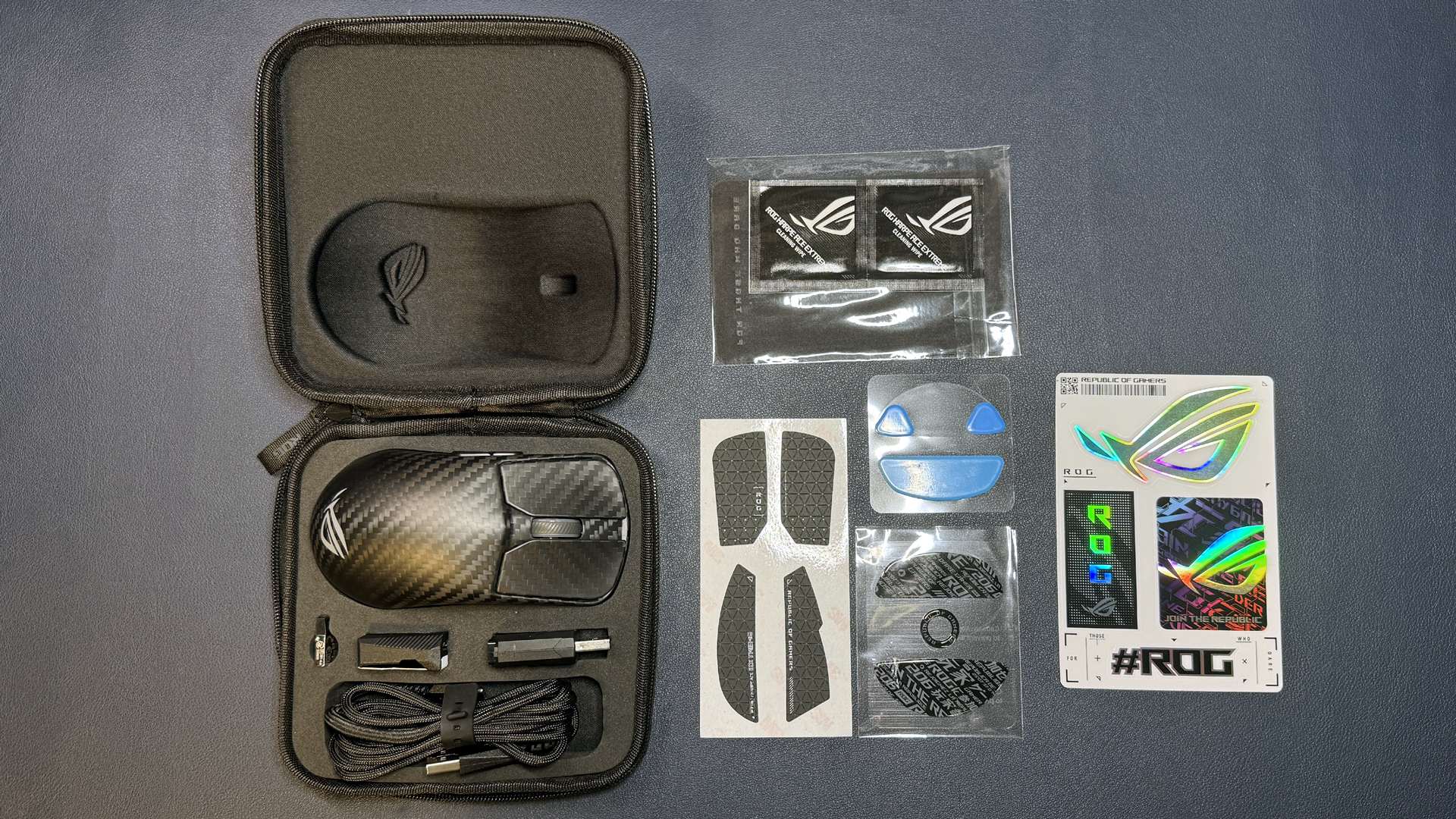Tom's Hardware Verdict
This high-end carbon fiber mouse is an excellent performer and extremely lightweight, but it's pretty basic for its $250 price tag.
Pros
- +
Very lightweight
- +
Comfortable
- +
Firm, tactile switches
- +
Great sensor and performance
Cons
- -
$250
- -
Stiff scroll wheel
- -
Battery life could be better
- -
Armoury Crate remains the worst peripheral software ever
Why you can trust Tom's Hardware
The Asus ROG Harpe Ace Extreme is the mouse side of Asus' "Extreme" peripherals — to match its $500 Asus ROG Azoth Extreme keyboard. This carbon fiber mouse is insanely lightweight (47g), with a classic, symmetrical shape and five programmable buttons (including the scroll click). Like the Asus ROG Keris II, the Ace Extreme sports Asus' ROG AimPoint Pro optical sensor, which has a maximum resolution of 42,000 DPI and a maximum speed of 750 IPS, and can handle up to 50 G's of force. It also features a wireless polling rate of up to 8,000 Hz with Asus' ROG Polling Rate Booster (included).
The specs are excellent. There's no doubt this mouse rivals the best gaming mice in accuracy, speed, and weight – and it should for $250.
Design and Comfort of the ROG Harpe Ace Extreme
The ROG Harpe Ace Extreme is made of carbon fiber, and it… looks like it's made of carbon fiber. Well, it's not made entirely of carbon fiber — the top half of its chassis is made of carbon fiber, while the lower half is made of lightweight plastic. This means the top of the mouse, including its two primary buttons, feature a distinctive carbon fiber weave pattern, while the bottom of the mouse is solid matte black plastic with light texturing on the sides.
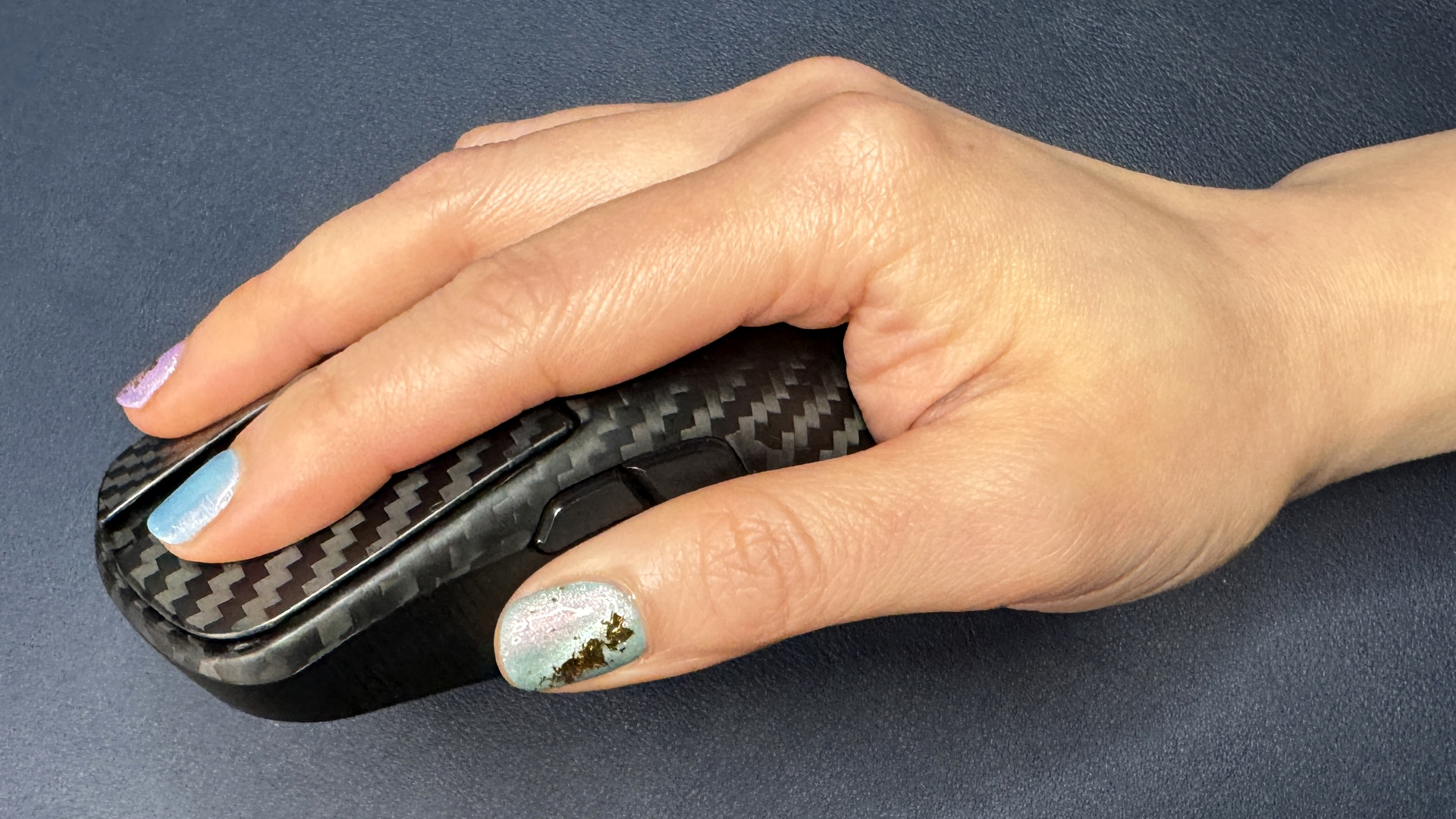

The mouse features the same right-handed symmetrical design of its less-extreme counterpart, the Asus ROG Harpe Ace Aim Lab Edition, which we reviewed last year. It has the same dimensions as that mouse, measuring 5.01 inches (127.5mm) long by 2.51 inches (63.7mm) wide by 1.56 inches (39.6mm) high at its tallest point. Thanks to its carbon fiber construction, however, it's lighter than the Harpe Ace Aim Lab Edition by 7g — the Harpe Ace Extreme weighs just 1.66 ounces (47g).




The Harpe Ace Extreme is not a small mouse, but it has a mild hump and a symmetrical shape that will work with a range of hand sizes. The sides curve in slightly and the mouse flares out at the top, making it easier to pick up and more comfortable to hold in claw and fingertip grips. It has a mild center hump that's slightly pointed so your fingers will fall on either side of it.
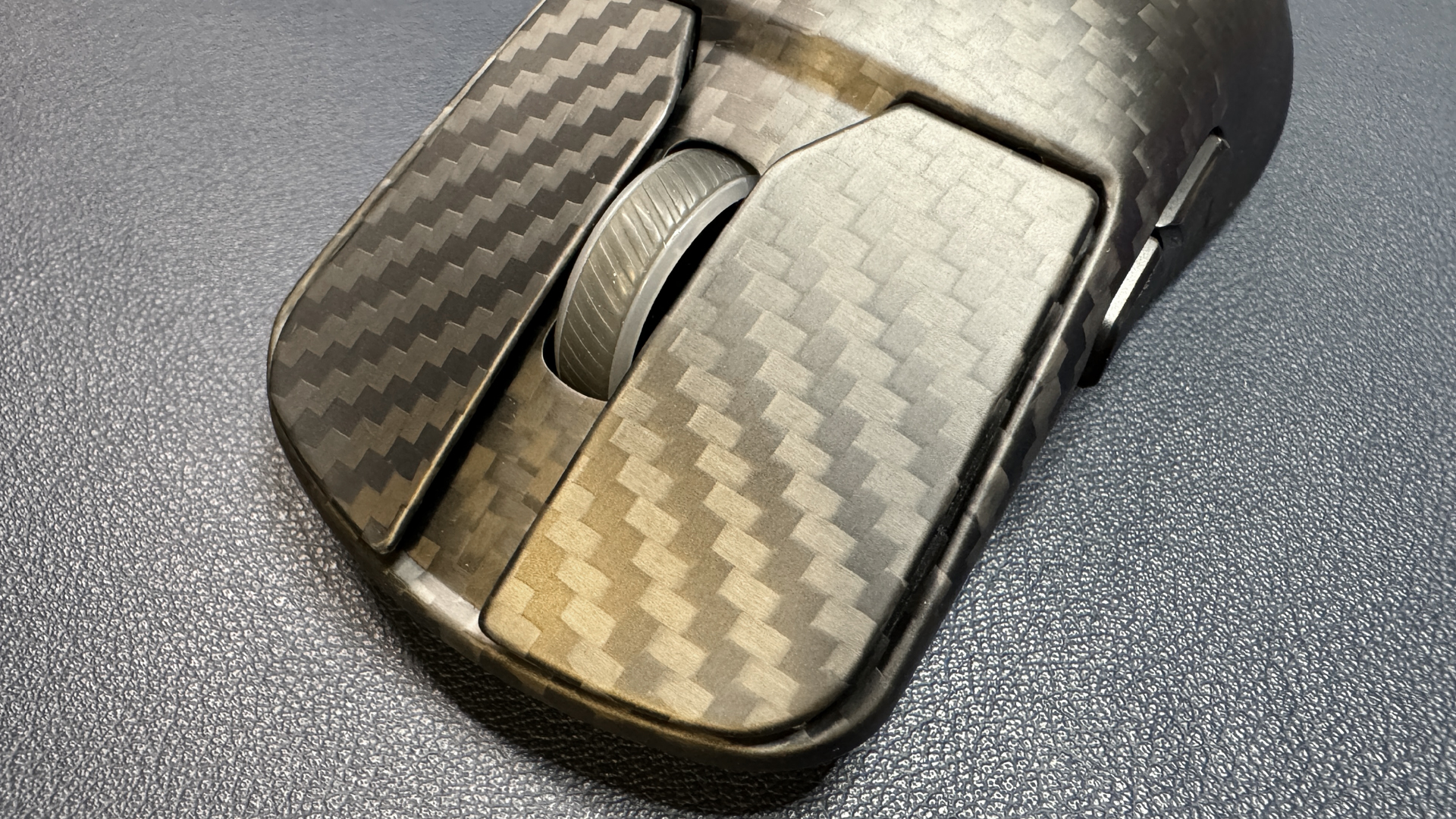

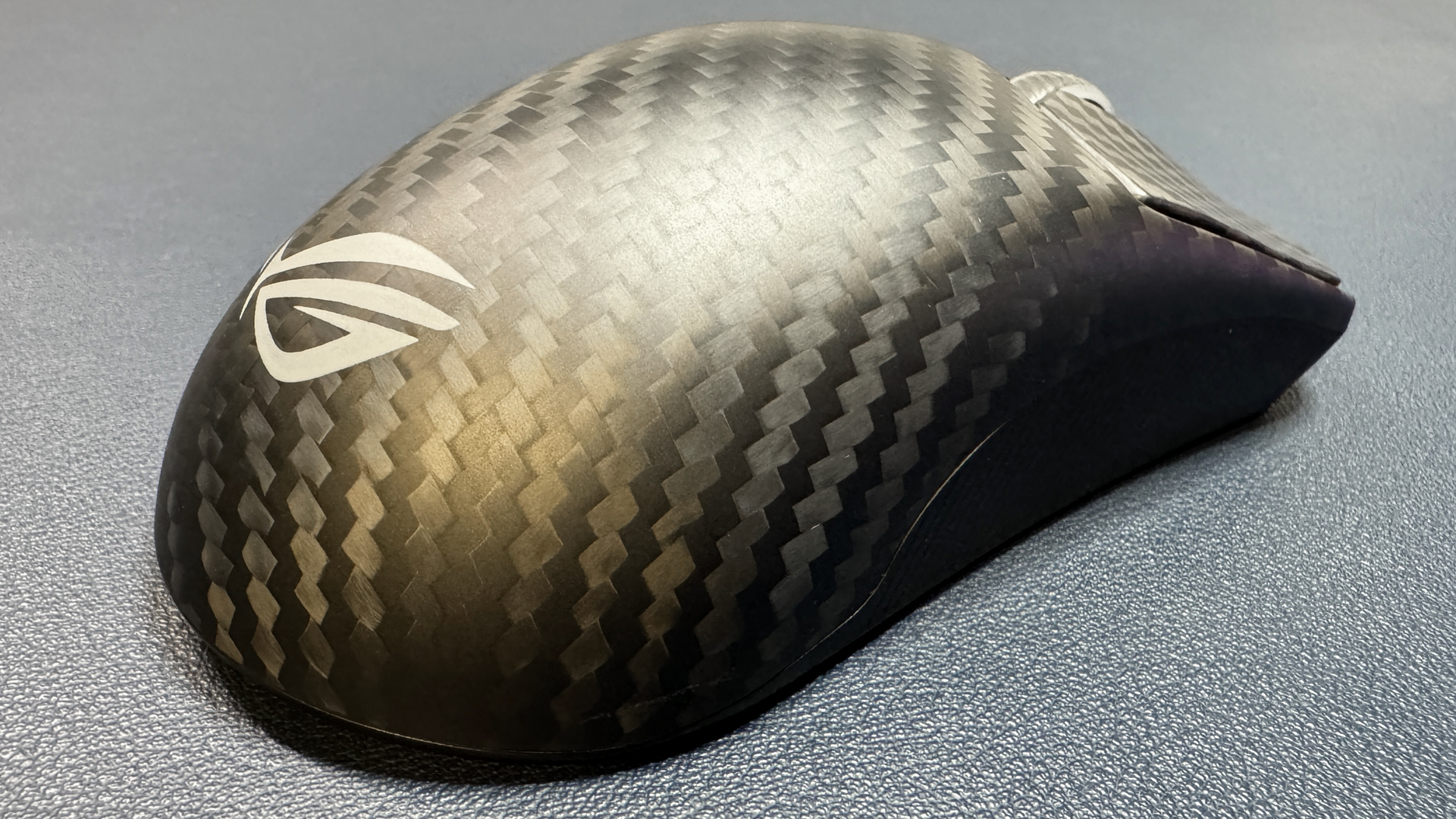
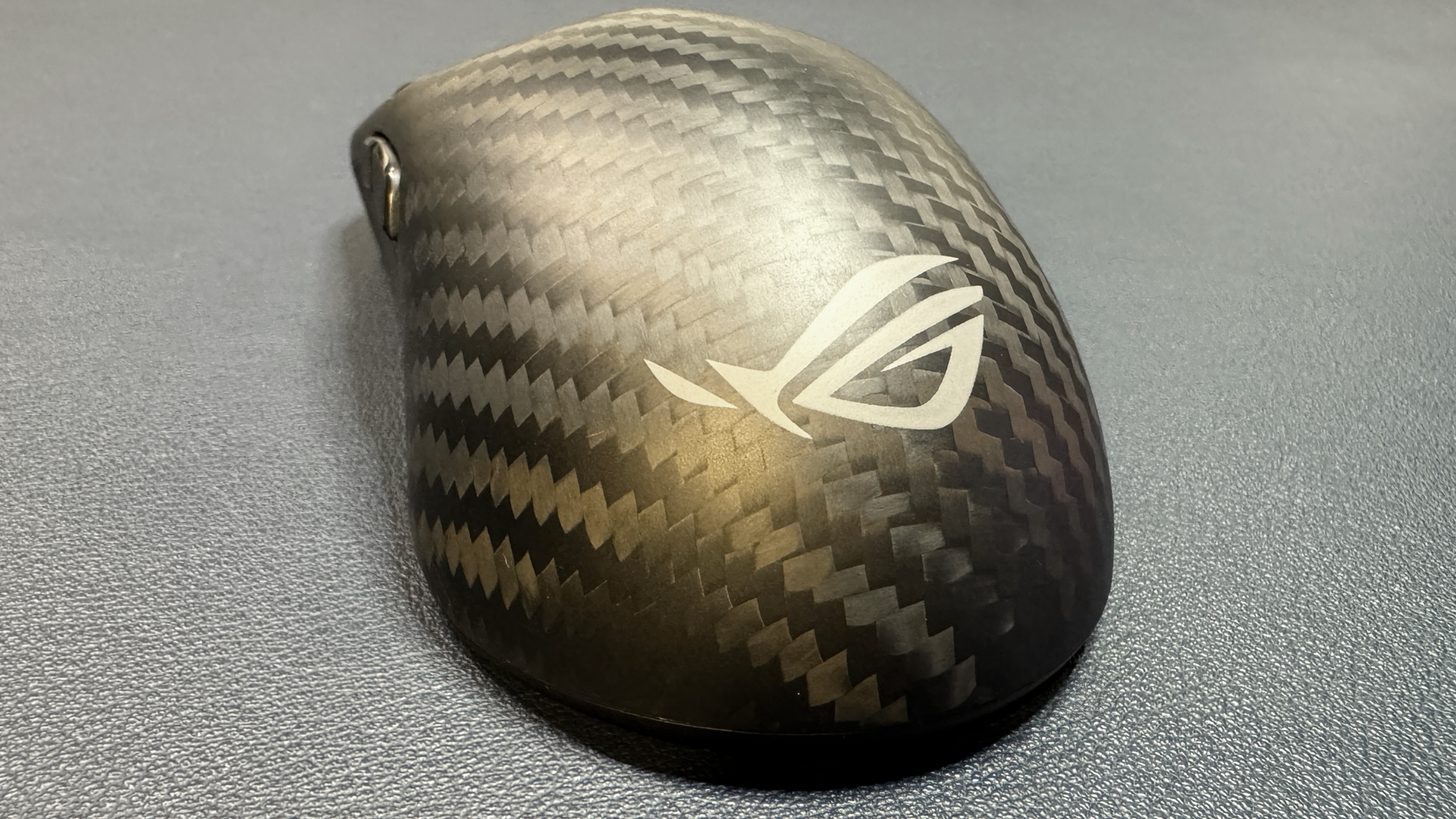


The primary buttons are mostly flat, with a slight curve toward the center of each button to help keep your fingers in place. It's easy to pick up because it's so lightweight, and even though the carbon fiber is smooth and a little slippery, the textured sides offer enough grip that you shouldn't have any trouble keeping this mouse in your hand. In the event that you do need a grippier surface, Asus includes precut grip tape with the mouse (for the sides and the primary mouse buttons).
The Harpe Ace Extreme is a simple mouse in many ways, and it has just five programmable buttons if you include the scroll wheel click. The two primary mouse buttons are programmable, as are the two thumb buttons on the left side. The scroll wheel click is programmable and so are the scroll wheel directions — so that's actually seven programmable inputs in all, though most people aren't going to reprogram the scroll wheel.
Get Tom's Hardware's best news and in-depth reviews, straight to your inbox.


There are two additional non-programmable buttons on the bottom of the mouse, one for switching between DPI steps and one for pairing The bottom of the mouse features pure PTFE mouse feet — a large semi-circle on the bottom and two triangles at the top, plus a strip around the optical sensor. There's a power switch for switching between 2.4GHz wireless and Bluetooth, a DPI switch button for cycling through DPI steps, and a pairing button for pairing the mouse with Bluetooth devices. Unlike the ROG Harpe Ace Aim Lab Edition, the Harpe Extreme doesn't have a spot to store its 2.4GHz dongle. This is probably because the Harpe Extreme comes with its own storage/carrying case (which fits all of the mouse's necessary accessories).
Speaking of which, the ROG Harpe Ace Extreme comes with a lot of accessories in the box. And the box, by the way, is just as over-the-top as the box that Asus' ROG Azoth Extreme came in:


The mouse comes with a padded storage case that fits the mouse, its 2.4GHz wireless dongle, the ROG Polling Rate Booster, a USB extender, and a 6.5-foot (2m) USB-C to USB-A cable. The cable is a flexible, low-drag paracord style that won't weigh you down too much if you want to use the mouse in wired mode.
The mouse also comes with two sets of extra mouse feet — one set of replacement PTFE mouse feet (the same as the feet that come installed), and one set of glass mouse feet that will give you even faster glide in some situations. Glass mouse feet have been around for a while — they can be speedier on soft/cloth mouse pads, but they wear out quickly (and can wear out the mouse pad, too), can be finicky when it comes to dust, and can't be used with glass mouse pads.
Rounding out the accessories are a couple of cleaning wipes and a polishing cloth, pre-cut grip tape, and some Asus ROG stickers.
Specs
| Sensor Model | ROG AimPoint Pro optical sensor |
| Max Sensitivity | 42,000 DPI |
| Max Speed (IPS) | 750 IPS |
| Max Acceleration | 50 G's |
| Polling Rates | 8,000 Hz (with ROG Polling Rate Booster) |
| Programmable Buttons | 5 |
| LED Zones | 1 |
| Cable | 6.5ft / 2m braided, USB-C to USB-A |
| Connectivity | 2.4GHz wireless, Bluetooth 5.1, wired (USB-C) |
| Measurements (L x W x H) | 5.01 x 2.51 x 1.56 inches / 127.5 x 63.7 x 39.6mm |
| Weight (excluding cable) | 1.66oz / 47g |
| MSRP / Price at Time of Review | $249.99 |
| Release Date | Sept. 18, 2024 |
Performance of the ROG Harpe Ace Extreme
The ROG Harpe Ace Extreme sports Asus' ROG AimPoint Pro optical sensor, which has a maximum sensitivity of 42,000 DPI and a maximum speed of 750 IPS, and can handle up to 50 G's of acceleration. This is an upgrade from the sensor found in the ROG Harpe Ace Aim Lab Edition, and is the same sensor found in Asus ROG Keris II Ace.
In its primary buttons, the mouse features Asus' ROG 100M optical micro switches, which are rated for — as the name suggests — 100 million clicks. These switches have a firm, tactile click that feels similar to that of the Logitech G Pro X Superlight 2. They're also on the louder side — not significantly louder than the switches you'll find in most mainstream gaming mice, but definitely not quiet.
The mouse has a notched scroll wheel with a TTC gold scroll wheel encoder that's rated for up to 1 million cycles. The scroll wheel is tactile, with firm, distinct steps. It's stiffer than I prefer — in fact, it was so stiff that I found it quickly fatiguing (my typical day includes a lot of scrolling, and I've been spoiled by dual-mode free-spinning wheels). Not everyone is looking for dual-mode or free-spinning scroll wheels, however, and this type of firmly delineated scroll wheel is good for short, precise scrolling. The scroll wheel is different from what you'll find in Asus' other gaming mice (the ROG Harpe Ace Aim Lab Edition and the ROG Keris II) — it's both more tactile and stiffer.
The ROG Harpe Ace Extreme is designed for fast-paced first-person shooters and competitive eSports (presumably, anyway). Its ultra-lightweight design slips quickly across your desk, and the AimPoint Pro optical sensor is sensitive, accurate, and consistent over a variety of surfaces, including hard, soft, and glass mouse pads, a wooden table, various fuzzy surfaces (e.g. blankets, dogs), and various shiny surfaces (stone countertop, opaque glass table top, lacquered tabletop). It's an excellent performer, but you'll get similar performance from other flagship gaming mice, such as the performance-focused Razer Viper V3 Pro (which also gets 8,000 Hz wireless polling rates).
Features and Software of the ROG Harpe Ace Extreme
The ROG Harpe Ace Extreme can be configured using either Asus' universal peripheral software Armoury Crate or the lighter-weight Armoury Crate Gear, which is, quite frankly, what Armoury Crate should be. Armoury Crate Gear has the standard array of features — button remapping, DPI and performance tweaking, lighting customization, and power settings, and the only real difference seems to be that it doesn't include the one million unnecessary extra features that Armoury Crate includes, such as... virtual pets? Interactive wallpaper? Some kind of Asus-branded digital... town?
It's nice that Asus has given us a less obnoxious version of Armoury Crate with its extreme peripherals, but Armoury Crate Gear still doesn't seem to be particularly lightweight. For one thing, the Harpe Ace Extreme version seems to be separated into four different apps, one for each form of connectivity (2.4GHz wireless, Bluetooth, wired) and one for the dongle, which is a little strange. Also, I keep getting popups asking if I want to install Asus' various other apps (including the virtual pet), and I can't tell if this is some residual Armoury Crate thing or if it's from Armoury Crate Gear or if it's just from the mouse itself. Regardless, it's annoying.








Both Armoury Crate and Armoury Crate Gear let you reprogram the mouse's buttons, adjust settings such as angle snapping, DPI, and polling rate, customize the mouse's RGB lighting, and update the mouse (and the dongle's) firmware. You can also change the mouse's power settings and check the remaining battery life and calibrate the mouse to a variety of different surfaces. There's not much to do as this is a pretty basic mouse, and Armoury Crate Gear still sort of seems like overkill.
Wireless Experience and Battery Life of the ROG Harpe Ace Extreme
The ROG Harpe Ace Extreme offers three forms of connectivity: 2.4GHz wireless, Bluetooth 5.1, and wired via USB-C. The mouse comes with a 2.4GHz wireless USB-A dongle, as well as Asus' ROG Polling Rate Booster (a USB-A pass-through dongle that you plug the 2.4GHz dongle into). The 8,000 Hz polling rate is only an option with 2.4GHz wireless connectivity; wired connectivity maxes out at 1,000 Hz. You do need to turn the mouse off in order to use it in wired mode.
Asus' rates the mouse's battery life at around 70 hours over 2.4GHz wireless with a 1,000 Hz polling rate and with the RGB lighting turned off (58 hours with the lighting turned on). This is decent, though most of the flagship wireless gaming mice (both ultra-lightweight and not) on the market today hit closer to 90+ hours. Of course, this number drops considerably if you up the mouse's polling rate to 8,000 Hz.
Bottom Line
The Asus ROG Harpe Ace Extreme is an ultra-lightweight wireless mouse with an easy, symmetrical shape, five programmable buttons, and up to an 8,000 Hz wireless polling rate. It's speedy, accurate, low-latency, and fairly comfortable — even with its relatively generic shape — but it's a pretty basic mouse for $250. The mouse features a carbon fiber top shell and a ton of accessories (including a carrying case and the ROG Polling Rate Booster, as well as grip tape, mouse feet, and even glass mouse feet), but it's still pretty difficult to justify a $250 price tag.
Of course, this isn't the first crazy high-end "extreme" version of a mouse — in fact, it's pretty similar to the Razer Viper Mini Signature Edition. The Viper Mini Signature Edition is a fancy version of Razer's performance-oriented Viper line with a magnesium alloy shell, a ton of accessories, and up to an 8,000 Hz polling rate, and it retails for $300. So really, the ROG Harpe Ace Extreme is practically a steal. But the Razer Viper Mini Signature Edition isn't exactly what I'd call a good deal, either.
If you're looking for a performance-oriented ultra-lightweight wireless gaming mouse, there are plenty of options that don't cost nearly as much — including Asus' own ROG Harpe Ace Aim Lab Edition, which retails for $100 less and can often be found on sale. There's also the slightly more ergonomic ROG Keris II ($160), which features the same sensor as the ROG Harpe Ace Extreme, and my still-favorite Razer DeathAdder V3 Pro ($150).
MORE: Best Gaming Keyboards
MORE: How to Pick Keycaps for Your Mechanical Keyboard
MORE: How to Build a Custom Mechanical Keyboard

Sarah Jacobsson Purewal is a senior editor at Tom's Hardware covering peripherals, software, and custom builds. You can find more of her work in PCWorld, Macworld, TechHive, CNET, Gizmodo, Tom's Guide, PC Gamer, Men's Health, Men's Fitness, SHAPE, Cosmopolitan, and just about everywhere else.
-
Notton Carbon fiber is an interesting material choice when Asus doesn't use it in anything else they have.Reply
And yet they only managed to hit 47g?
I have an all-plastic 5-button wireless mouse that is 43g that remains comfortable and sturdy.

